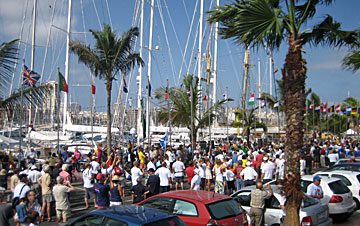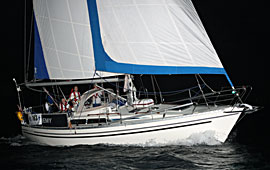|
|
|
| From Las Palmas in Gran Canaria to Rodney Bay in St.Lucia |
| 22nd November to 11th December |
|
| Report & Photos by Cyril Geran |
|

Yachts, sailors & onlookers at Las Palmas in Gran Canaria
|
The ARC (Atlantic Rally for Cruisers) takes place each year in late November leaving Las Palmas in Gran Canaria and sailing to Rodney Bay in St. Lucia, a distance of just under 3000 miles. The timing of the event coincides with the end of the hurricane season, the establishment of the Azores trade winds and to allow time for the yachts to arrive in the Caribbean.
Approximately 220 boats assemble in Las Palmas for the start of the event. The last few days before the "off" are frenetic with briefing, seminars, provisioning, safety checks, parades and last minute preparations.
|

Alchemy - Moody 42.5
|
Alchemy, our boat is a Moody 42.5 launched in 1990 with a reg. Tonnage of 17.14 tons. She has a draft of 1.14 metres. In 2009 she had a new Volvo engine fitted together with a new generator, water maker, chart plotter & electric winches. She is also fitted with an in-mast furling main, auto helm, bimini, radar & freezer. We flew Howth Yacht Club battle flags in Gran Canaria before departure and in St Lucia after arrival.
|

(L-R) Ralph Murphy, Cyril Geran, Bernard O'Connell, Stuart McDowall
|
Our crew of 4 were Ralph Murphy, owner, Bernard O'Connell, both from the UK, Stuart McDowall from Canada and yours truly. As the combined ages of the crew was 278 years we could really describe the team as geriatric. Apart from age we were a diverse group. Ralph was British attache in Washington and Cuba etc and subsequently sales director of Rolls Royce Aero Engines. Stuart is ex Canadian ambassador in Cuba Africa, Middle East. Bernard was the owner of an advertising co. and bringing up the rear, me, with a marine insurance background.
|
Stocking up with Provisions
We provisioned in El Corte Ingles (the large Spanish chain store group).
They provide an excellent packing and delivery service, including freezing meat and fish. The pontoons on the marina were full of food and drink being loaded into yachts. You must not take the cardbord boxes aboard to keep cockcroaches of the boat.
|

Stocking Up
|
|
I brought 40 packets of Odiums bread mix from Ireland as we wanted to bake fresh bread every day. This proved to be a great success.
The boat was loaded with more groceries than the average SPAR and more wine than Odd Bins. At least we would not starve to death in the event of the helm getting us stuck in circles in the middle of the Atlantic.
|
Departure Day - Sunday, 22nd November
|

Boats heading out
|

Well wishers wave farewell
|
Departure day itself was exciting. Brass bands marching up and down the quay, crowds out in their summery best, some guy on a loud speaker calling out the boat's name as each one left the marina, very much like radio commentators shout "GOAL" in Mexico at football matches.
The racing division, of about 20 boats, started at 1240. The cruising division of about 200 boats started at 1300. The sailing instructions stated "leave Gran Canaria to starboard and St. Lucia to port and finish in Rodney Bay", approximately 3000 miles away.
There is an acceleration zone down along the island which increases the wind by 10/15 knots. This gave a choppy sea which produced some seasickness. At the south end of the island there is a wind shadow which extends for about 30 miles. A decision as to when you turn west must be taken. If this is taken too soon one can encounter calms. There is a cliche which says "go south until the butter melts".
Our Watch System
Our watch system was 2 hours at night and 3 hours during the day. We had estimated being at sea for 20 days so each crew was on cooking duties 5 times. The person who was cooking was relieved of watches during that day (not night). This also moved the watches 1 hour forward each day.
We were on a course of 180 deg for 3 days. Some crew members had doubts and assumed we were emigrating to Senegal. However we turned on to 250 deg in NE winds of 17/20 knots.
|
Our secret weapon was the "Twizzle"
( click above for details )
This is a large spinnaker type sail which is hoisted, sausage like, with its own furler. It is set with twin poles which are attached to an articulated fitting which is secured by an uphaul and a downhaul which pulls it forward of the mast.
The idea is that because the poles are not attached to the mast it reduces rolling. The rolling motion was certainly less than my previous crossing.
However we found the sail difficult to control when the wind increased. The furler was too small and the continuous rope which reduced the sail tended to slip which of course opened the sail again. We also had difficulty in getting the poles under control.
However we had our best days sail of 178 miles under the vsail.
We eventually reverted to the traditional main with poled out genoa.
|

The "Twizzle"
|
Our SSB reception was poor and we relied on our satellite (IRIDIUM) phone. We were getting reports that many boats had weather problems including 1 sinking and a couple of craft diverting to the Cape Verde islands for repairs. The winds were generally ENE to E 15/20 knots ... seas 3-4 metres.
Friday, 27th November
Sunny weather, temperature 25C. Started fishing today. Some sea birds around. They are grey and look like fulmars, of course we are still within 200 miles of the Cape Verde Islands. Wonderfull waxing moon each night. We have just been visited by a large school of dolphins.
We have also seen our first flying fish. They are quite small. We were also visited by a pilot whale about 30 feet long. Passed way point today. I brought a rich fruitcake (made by Aideen Jeffares) which we opened to celebrate. As you pass each 15 degrees west you set your watch back 1 hour.
|

Bernard & Stuart enjoying the Sun
|

Bernard on Watch
|
Day follows day with warm sunny weather (a bimini is essential) and following trade winds. Life aboard Alchemy was good and the "craic was mighty". Both Ralph and Bernard attended Christin Brothers school in Bristol and were familiar with Irish Songs. Bernard brought his guitar with him. We sang a lot - largely out of tune - from songs that featured on the "Light" programme in the 50s, to stuff that would allow you escape with your life on the Falls Rd.
We had a nasty electric storm which lasted a whole night. With tropical rain the wind increased to 35 knots and veered 50 degrees. It had us heading for a landfall near the Amazon. In the middle of all this another pilot whale surfaced beside us and gave us a watery look which led us to wonder that Jonah might be calling us. With the possibility of a lightning strike and the subsequent damage to our electronic equipment I put both the handheld vhf and gps in the microwave oven to create a "Faraday" cage.
To add to our woes that night I discovered that the aft cabin was like a sauna enveloped in steam. The thermostatic valve in the calorifier had malfunctioned allowing the water to overheat. This in turn melted some of the water connections. As a result we lost our water and burned out our starter battery. Undaunted we commandeered the bow thruster battery and all was well again.
We had a few slow days which caused us a little anxiety as we began to feel that not only would the party be over by the tme we arrived in St Lucia but the ARC committee might be into planning next years event.
|
Tuesday, 8th December
500 miles to go. Noticed the fishing line jumping - a fish on the line. Hauled in the line and a large fin appeared. We landed a beautiful large blue and yellow fish with a long saw like mouth. While we were getting alcohol to pour on its gills (the easiest way to subdue a fish) it took a mighty leap back into the ocean.
When we consulted our chart it was a blue marlin which should be tagged and released. We were glad it got away.
|

Blue Marlin
|
We were surprised to discover that we had run out of credit on our Sat. phone. With the SSB not working we were now out of communication with the outside world except for VHR. As you go westword you encounter more squalls with short sharp showers and strong winds.
Friday, 11th December - sighted St. Lucia
At about 1400 we sighted St. Lucia on the port bow. Enough excitement to finish off Aideens cake.
|

|

|
| Crossing the finish line |
The final approach to St. Lucia was at dusk under a reddening sky. Full darkness fell as we rounded Pigeon Island for the finish. The last mile is on the wind which is strange after 3000 miles of downwind sailing. We could scarcely see the narrow entrance to the marina so we tagged along behind a Rum Runner boat after an evening drinking in the bay.
|

Alchemy alongside in Rodney Bay Marina, St. Lucia
|
Once alongside, St. Lucia greeted us warmly with rum punches and fruit baskets. Other ARC crews called by to offer congratulations - no one really cares what position you took - only that you arrived safely. The next few days were taken up with parties, celebrations, meeting up with other boats and retelling each others experiences and adventures.
|
We completed our voyage in 19 days - one less than planned. It is impossible to spend 3 weeks gazing at the immensity of the sea and sky at night without gaining a new perspective on Iife.
|
More Photos from St. Lucia |

|

|
| The Marina Complex |

Collecting the Laundry
|

|

Local Town
|

Cyril Geran
|

|

|
| Up the Coast |
|
|

